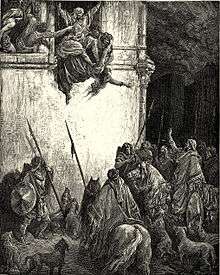Jezreel (city)
| Yizre'el | |
 Tel Jezreel looking east toward Gilboa. | |
 Shown within Israel | |
| Location | Yizre'el, Israel |
|---|---|
| Region | Jezreel Valley |
| Coordinates | 32°33′28.27″N 35°19′40.63″E / 32.5578528°N 35.3279528°E |
| Type | palace |
| Part of | town |
| History | |
| Builder | Tribe of Issachar, Ahab |
| Material | stone |
| Cultures | Hebrew, Kingdom of Israel |
| Associated with | Ahab, Jezebel, Naboth, Ahinoam, Jehu, Elijah |
| Site notes | |
| Excavation dates | 1990-1996 |
| Archaeologists | David Ussishkin, John Woodhead |
Jezreel (Hebrew: יִזְרְעֶאל (yizrăʕɛʔl) Yizre'el, "God soweth") was an ancient Israelite city and fortress originally within the boundaries of the Tribe of Issachar,[1] and later within the northern Kingdom of Israel. According to the Book of Kings, the royal palace of King Ahab in Jezreel was adjacent to the vineyard of Naboth. Prior to the division of the United Kingdom of Israel, the city was also the hometown of Ahinoam, first wife of King David.
The modern archaeological site is located on a low hill on the southern edge of the Jezreel Valley's eastern edge in northern Israel.[2] Archaeologists David Ussishkin and John Woodhead believe that Jezreel was a fortress that served as a cavalry base for King Ahab.[2]

Biblical
As recounted in 2Kings 9:1-37, after Jehu kills King Jehoram, he confronts Jezebel in Jezreel and urges her eunuchs to kill Jezebel by throwing her out of a window. They comply, tossing her out the window and leaving her in the street to be eaten by dogs. Only Jezebel's skull, feet, and hands remained.
In 2Kings 10:8 Jehu orders the death of 70 descendants of Ahab, and has their heads sent to the new king in Jezreel and piled up "in two heaps at the gate entrance."[2]
The "breathtaking views" that the site commands to the north and east are considered to have been of strategic importance in Israelite times because the commercial and military highway from Egypt to Syria and Mesopotamia passed through Megiddo, Beth Shean and along the Jezreel Valley.[2] Water was supplied by cisterns inside the walls and by the spring of 'En Jezreel northeast of the fortress.[2] Because of the strategic location, ample water supply, and excellent grazing in the Jezreel Valley, archaeologists David Ussishkin and John Woodhead believe that Jezreel was the base for King Ahab's chariot corps and cavalry.[2]
History

Jezreel was a 9th-century BC fortress possibly built during the reign of King Omri but certainly active in the reigns of King Ahab and his consort Queen Jezebel and their son King Jehoram.[2] It was destroyed soon afterward, possibly by the Arameans in the late 9th-century.[2][3] The pottery found in the fortress during the dig all dates to this brief period.[2]
The fortress was built on the site of a small village that existed in the Early Bronze Age (c. 2750-2300 BC) and Late Bronze Age (c. 1550-1150 BC).[2]
The fourth-century Christian nun and pilgrim Egeria visited Jezreel and reported that "the tomb of Jezebel is stoned by everyone to this very day."[2]
Jezreel was the site of a Byzantine-era village, a Crusader-period village belonging to the Knights Templar, and an Arab period village named Zir'in (derived from the ancient name Jezreel).[2] A "beautiful Crusader church still stands largely intact.[2] Benjamin of Tudela visited Jezreel in 1165 AD and reports that a Jewish man "a dyer by profession" lived there.[4] It was the site of a large Ottoman-era fortified tower.[2] During the Israeli War of Independence the village of Ze'rin "became a central base for Arab forces" and was therefore conquered and the site cleared.[2]
Archaeology
Archaeologists David Ussishkin and John Woodhead led a dig at Jezreel.[2] In 1987 a bulldozer working near the site accidentally uncovered ancient structures, and a salvage dig was conducted, leading to the major dig under the direction of Ussishkin and Woodhead over seven seasons from 1990-1996.[2] Staff and volunteers from about 25 countries (the largest groups were from United Kingdom, Sweden and Denmark) joined the dig. Renewed excavations are planned to start in the summer of 2012 under the new directorship of Norma Franklin (University of Haifa Zinman Institute of Archaeology) and Jennie Ebeling (University of Evansville).[5]
The excavations uncovered a casemate wall and four projecting towers surrounding the fortress, built with a combination of well-cut ashlars, boulders and smaller stones, and an upper level of mud-brick. The fortress enclosed an area of almost 11 acres (45,000 m2). It was 860' long and 470' wide, and defended by a steep slope to the north and a moat 20' deep and rampart on the other three sides.[2]
References
- ↑ Joshua 19:18
- 1 2 3 4 5 6 7 8 9 10 11 12 13 14 15 16 17 18 David Ussishkin, "Jezreel—Where Jezebel Was Thrown to the Dogs", Biblical Archaeology Review July / August 2010. Read Online
- ↑ Nadav Na'aman, "Historical and Literary Notes on the Excavation of Tel Jezreel," Tel Aviv 24, 1987, pp. 122-128.
- ↑ Asher, Adolf, The Itinerary of Rabbi Benjamin of Tudela, Hakesheath, New York, 1840, p. 80.
- ↑ Biblical Archaeology Review, May/June 2013